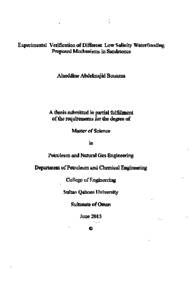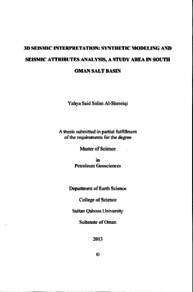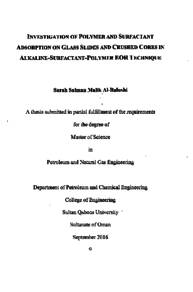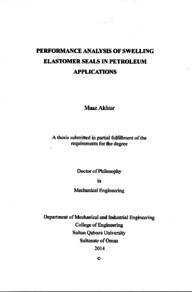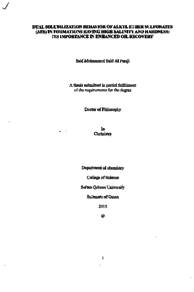Document
Experimental verification of different low salinity waterflooding : proposed mechanisms in sandstones
Publisher
Sultan Qaboos University
Gregorian
2015
Language
English
English abstract
Low salinity waterflooding (LSWF) research has gained more momentum in recent years for both sandstone and carbonate reservoirs. Published laboratory data and field tests showed an increase in oil recovery by changing injected brine salinity, especially for sandstone reservoirs. The main objective of the current study is to investigate/verify different mechanisms (fines migration, multi component ion exchange, rock dissolution and pH increase) proposed for the increase in oil recovery as LSWF takes effect. The impact of LSWF on oil recovery was investigated by conducting coreflood experiments using Berea cores, light crude oil and synthetic brine. The brine was diluted by mixing it with de-ionized water, Two sets of coreflood experiments (at 100% water saturation and at irreducible water saturation) were conducted in this study. Measurements of cations concentration (Mg2+, Ca2+ and A13+) in the coreflood effluent samples, pH, turbidity and ion exchange analysis as well as permeability and pressure drop, indicated that fines migration and rock dissolution mechanisms do exist in low salinity waterflooding in sandstones. The critical salinity at which fines start moving was observed to be around 670 ppm. The reduction in absolute permeability due to fines migration goes up to 60% of the initial permeability. No indication of multi-component ion exchange and pH increase suggested mechanisms was observed from the LSW coreflooding.
Description
Thesis
Member of
Resource URL
Arabic abstract
اكتسبت بحوث الغمر بالماء قليل الملوحة (LSWF مزيدا من الاهتمام في السنوات الأخيرة لكل من مكامن الحجر الرملي و الكربوني، و لقد أظهرت التجارب المخبرية والميدانية زيادة في إنتاج النفط من خلال تغيير ملوحة ماء الحقن و خاصة بالنسبة إلى مكامن الحجر الرملي. يتمثل الهدف الرئيسي للدراسة الحالية في فحص التحقق من عدة آليات مقترحة لتفسير زيادة إنتاج النفط عند الحقن بالماء قليل الملوحة وهي ارتحال الدقائق، والتبادل الأيوني متعدد المكونات، والتحلل الصخري، وارتفاع قياس عامل الحموضة (pH). تم التحقق من تأثير الماء قليل الملوحة على إنتاج النفط بإجراء تجارب الغمر بالمياه (coreflood) باستخدام عينات لحجر Berea الرملي ، نفط خام خفيف و محلول ملحي اصطناعي. تم خلط المحلول الملحي مع الماء المنزوع الأيونات لتخفيف الملوحة. وقد تم استعمال نوعين من تجارب الغمر بالمياه خلال هذه الدراسة و ذلك عند التشبع التام بالماء و عند التشبع بالماء الغير القابل للإستخلاص. تم الاستدلال على وجود آليتي ارتحال الدقائق و التحلل الصخري أثناء الحقن بالماء القليل الملوحة و ذلك بقياس تركيز الأيونات الموجبة ('Mg و Ca و**Al) للماء المخرج من تجارب الغمر بالمياه، واحتساب عامل pH، والتحليل التبادل الأيوني واحتساب النفاذية وانخفاض الضغط للعينات . تمت ملاحظة نسبة الملوحة الحرجة التي يحدث عندها ارتحال الدقائق بمقدار 670 جزء من المليون. ولقد تم احتساب انحدار النفاذية الكلية بسبب ارتحال الدقائق بمقدار 60% من قيمتها الأولية أثناء الحقن بالماء القليل الملوحة. ولقد استدل على عدم وجود آليتي التبادل الأيوني متعدد المكونات وارتفاع قياس عامل الحموضة (pH) أثناء معاينة نتائج القيام بحقن الماء القليل الملوحة في تجارب الغمر بالمياه (coreflood) .
Category
Theses and Dissertations

